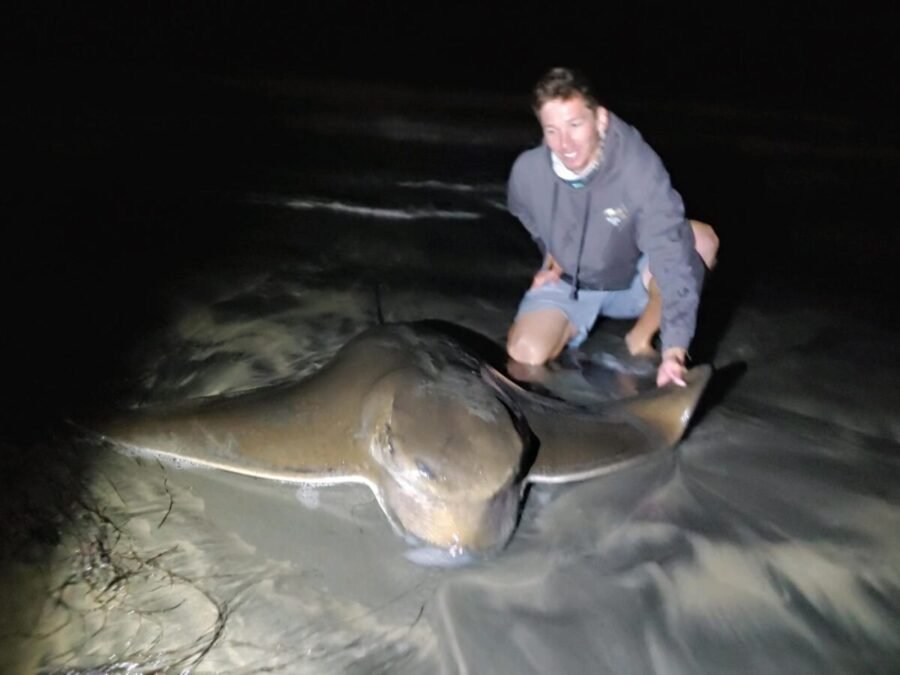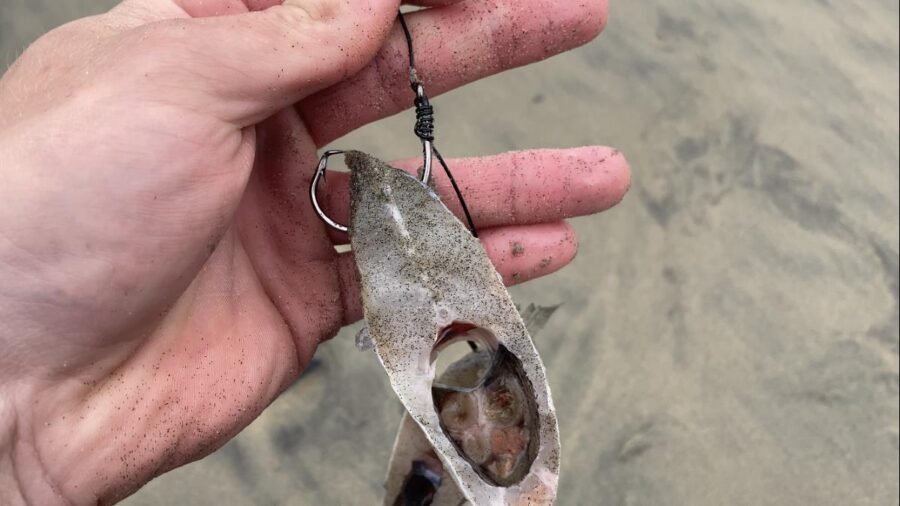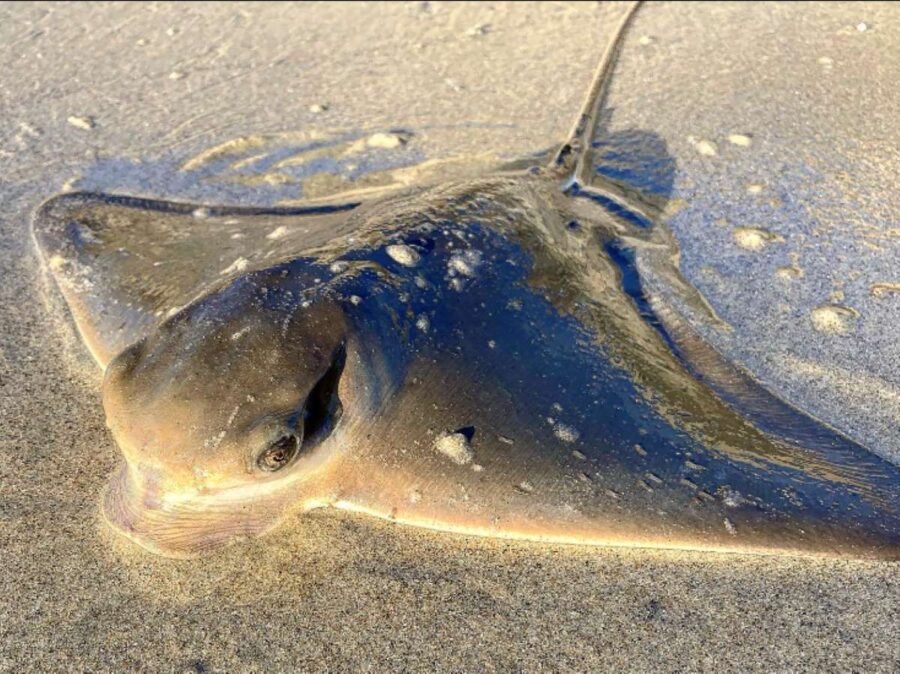Bat Ray Fishing: The Strongest Fish in the Surf

Not many anglers set out to catch bat ray as an intended target. For most anglers, targeting the biggest fish in the surf means surf fishing for sharks. But, whether bat rays are your target or not, if your fishing for sharks from the beach, you should be prepared to catch and handle one of these beasts.
About The Bat Ray
Earning the nickname “mud marlin” the bat ray is without a doubt the most powerful fish in the surf. Aside from an occasional great white cruising through, bat rays are the most powerful and strongest fighting fish in the surf.
There is no question, nor an option to debate. If you’ve experienced hooking into a bat ray with a 50+ inch wingspan, you’re in for a ride… a very long one.
In this overview, we’ll talk about the best bait for bat ray fishing, the best rigs for bat ray fishing, and the best rod and reel to handle not only sharks and rays, but bat rays as well. We’ll touch on their range, habitat, size, and much more.
| Common Names | Bat ray, mud marlin, bat |
| Legal Limit (#) | N/A |
| Legal Size (in) | N/A |
| Record Size (in/lb) | 66 inches | 183 lbs |
| Typical Size (in/lb) | 24-48 inches | 5-90 lbs |
| Fighting Strength (-/10) | 10/10 |
| Range | Gulf of California – Oregon Coast |
| Habitat | Muddy or sandy, estuaries and bays, kelp beds and rocky-bottoms |
| Bait | Squid, cut bait, sand crabs and others but those are best |
| Peak Season | November – April |
Rods, Reels, Gear and Tackle for Bat Ray Fishing
The setup listed below is exactly what I use when go fishing for leopard sharks, soupfin sharks, and bat rays. This set up can handle anything and everything you might hook from the shore.
- Rod: Fiblink Moonsniper (12 or 13 feet)
- Reel: Penn Battle 8000 (II or III)
- Main Line: 50-pound braid
- Topshot: 100-pound nylon coated mono
- Leaders: Shark Leaders
- Weights: 8-ounce pyramid or 6-ounce sputnik
For all the visual learners out there, targeting bat rays is near identical to targeting sharks from the beach. Check out the video below on leopard shark fishing.
The big bat ray in the image at the top of this page (along with almost all other bat rays I’ve caught) was caught on the same setup mentioned above with the same tactics in this video.
Best Rig For Bat Ray Fishing

A simple 3-way rig is the best rig for shark and ray fishing from the surf. You’ll here some guys make arguments for the pulley rig, but keep it simple with the 3-way as this provides a stronger connection and it’s much more affordable.
Best Bait for Bat Rays

If I were to head out with bat ray as my main target, it’d be a toss up between squid and fresh cut croaker or surf perch. It’s a tough decision to call one the best bait for bait ray fishing.
When surf fishing with squid, you’ll catch more rays than you will sharks, but size could range from tiny to large. When surf fishing with cut bait, you’re more likely to catch larger sharks and larger rays. I always lean toward targeting the bigger sharks and rays so I fish with cut bait.
One more thing to note is that bat ray will also eat sand crabs. It’s also absolutely possible to catch some big bat rays when surf fishing with sand crabs. So, be prepared and use a set up like the one shown below when targeting fish like corbina, surfperch, and croaker. Don’t use anything too light.
- Rod: Okuma Celilo (8’6″ MA)
- Reel: Penn Battle II or III 4000 series
- Mainline: 15-pound monofilament
- Carolina Rig (descriptive article/video):
- Leader Line: 15-pound fluorocarbon
- Swivels: 15-19mm barrel swivels
- Hooks: size #2 or #4 owner mosquito hooks
- Weights: 1-oz egg weight
- Beads: 8mm fishing beads
Where to Catch Bat Ray
You can catch bat rays just about anywhere, but sandy flats are your best bet. Additionally, when fishing sandy areas, you don’t have to worry about your line snagging reef or other structure.
Facts About Bat Rays

- Bat rays wings are used not only to swim, but to help uncover buried prey like clams.
- The barb of a bat ray is only used in self-defense and can grow to nearly 4 inches.
- Some catches have been reported to weigh over 200 pounds.
- The bat ray has teeth fused into powerful plates that can crush sturdy clam shells.
- When eating, it uses its strong jaws to crush things like a whole clam or other mollusks in its mouth, spits out the broken shells, and then eats the soft, fleshy parts.
- Should a tooth break or wear out, a replacement emerges.
- Rays continually grow new teeth, much like their shark relatives.
If you’ve got any questions about tactics or need any advice, feel free to reach out. I’m happy to help!
The article is spot on, my PB bat was 57 1/2″, My back hurt for a week
57 is massive! I’m sure the back was feeling it. They put a hurting on you for sure!
How do you handle a bat ray when releasing them? I’m scared of being stung about my face, neck and body by their fearsome stingers.
As bad as it sounds, grab it by the booger holes, drag it onto the sand, and unhook it. Stay away from the cemetery of its body and the back and you’re good.
The bigger the batray, the less you have to worry about because their range of “scorpion jabbing” is limited moreso in their comparison to body size. Small can reach their heads while bigs can only reach their center of their body. It’s just the barb that you have to worry about, not the tail.
We used to hook those things off a pier in Montecito, huge! Never got one in!
They would be near impossible to bring up from a pier!
I landed a 32 incher off Huntington Beach pier with a drop net, anything bigger than 40 might not even fit in most nets to be honest though.
I would agree as to their strength, but having been spooled by yellows from the beach in Asuncion, maybe with that exception. Yellows hooked in shallow water tend to run out as hard as they will run down to the reef as they do especially in BdLA and other spots. A huge difference than fighting them in LJ in 90′ of water. The fish were breaking right behind the surf in front of the little house I rented, and they weren’t the ‘normal’ small ones. probably in the 25-30-pound range, judging by their boils and slashes. They do get them occasionally large from the beach in Asuncion, a friend caught a 58# yellow from the rocks by the point there back in the 80s. I hooked up two and both ran straight out, spooling me on gear I know I could have (maybe, lol) landed a 100-pound bat on.
My largest bat landed was 58″ on a boat in San Quintin, and I had one on that would have been close to if not a record on the kayak in the Boca there. On that fish, I was pulling…well, it was pulling me… for over two hours. A commercial pangero came by and stood by to see if he could help. Once I saw it was a huge bat, I said he could have it. I thought maybe a mero, but there was the telltale ‘buzz’ in the line. He broke his ‘gaff’, rather straightened it, as it was sharpened #3 rebar, and I gave him mine. He stuck a wing, and it nearly pulled him out of the panga, flipped off the gaff, the knot finally gave, and it was gone. About a 6′ wingspan. The pangero said,’chinga su madre, perdido tres mil pesos!’. The 58″ weighed 73 kilos at the fish market.
I used to get a bunch of fat sardines off the boat when the afternoon half day returned to Islandia and go post up at the bench on Mariner’s Point where the little bay entrance is on the north side and would catch some nice ones just to pull on something heavy. If I did get them to the rocks, I would just dyke off the hook and let them go. Fresh dead sardine is a great bait for them.
Wild stuff! Yah I’m not sure I’d call a yellowtail a surf species but I did get this 53.5 pounder with a client a few years ago. http://surffishingsocalsd.com/world-record-yellowtail-caught-from-shore/
I got to fight it for the first 2 minutes or so and it was certainly a more powerful initial run, but the 58” bay I got was a much more “overall powerful” fight. They’ve got much more power per stamina than yellows do for sure. But yah yellows are extremely powerful in terms of how quickly they can run.